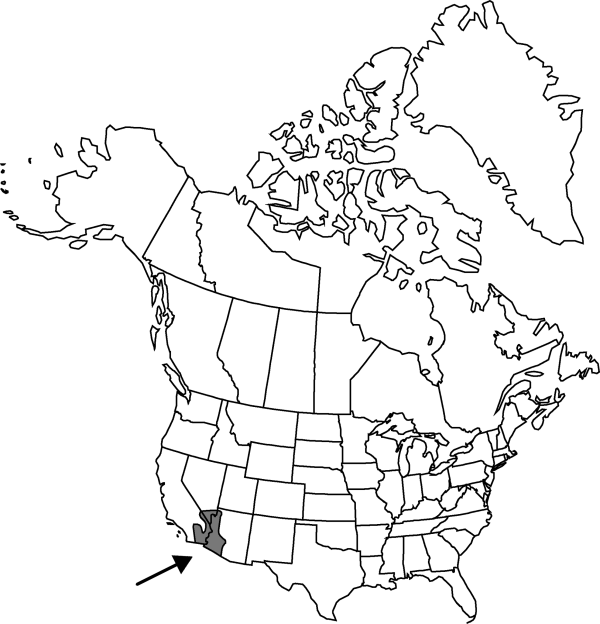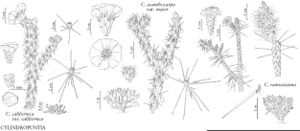Cylindropuntia ramosissima
in C. Backeberg and F. M. Knuth, Kaktu s-ABC, 122. 1935.
Trees or shrubs, intricately branched, 0.5–2 m. Stem segments firmly attached, green drying gray and ropelike, cylindric, 2–8 (–10) × 0.4–1 cm; tubercles rhombic, convex (flattened upon drying), 0.4–0.8 cm; areoles subcircular abaxially, adaxially becoming usually deltate-linear; glochid-bearing portion protruding distally, wedged between bases of 2 adjacent tubercles, (3–) 4–7 × 1–1.5 (–2) mm; wool tan to white. Spines 0–5 per areole, usually in distal areoles or sometimes absent or nearly so, tan to redbrown to deep purple, aging gray; major abaxial spines 0–1 (–2), the longest spine spreading, (1.5–) 2.5–6 cm; adaxial spines usually reflexed, short to ± 1 cm; sheaths baggy. Glochids in subcircular to linear adaxial tuft, yellow to tan to brown, to 2 mm. Flowers: inner tepals bronze-red ± suffused rose, with mid stripes darker, ovate, 6–13 mm, acute-apiculate to attenuate; filaments greenish; anthers yellow; style whitish or blushed with rose-pink or light green; stigma lobes whitish. Fruits maturing tan, ellipsoid to stipitate-ellipsoid, 15–30 × 10–15 mm, dry at maturity, tuberculate, developing increasingly burlike, with many bristlelike spines; areoles (32–) 40–66, evenly spaced, woolly. Seeds pale-yellow to tan-gray, angular to squarish in outline, warped, 4–4.5 × 3.5–4 mm, sides irregularly concave-convex; girdle smooth. 2n = 22, 44.
Habitat: Mojave and Sonoran deserts, washes, flats, and bajadas, sandy loam, desert pavement, stony volcanic substrates
Elevation: 50-1100 m
Distribution

Ariz., Calif., Nev., Mexico (Baja California, Sonora).
Discussion
Selected References
None.
